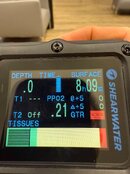I am familiar with the DAN guidance on flying after diving. My question is why ones dive computer, if it shows the theoretical tissue loading by compartment, isn’t sufficient to determine safe time to fly?
For example, the image below shows the modeling of my tissue loading 8 hours after a relatively shallow dive this morning.
Thanks in advance for the explanation.
For example, the image below shows the modeling of my tissue loading 8 hours after a relatively shallow dive this morning.
Thanks in advance for the explanation.




